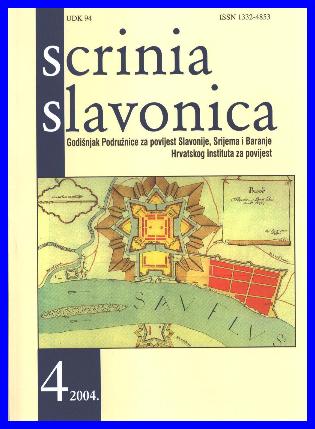Mjesto svadbe bana Tvrtka I i franjevački samostan “Sveti Ilija”
Ban Tvrtko I’s wedding place and the Franciscan monastery of “Saint Elias”
Author(s): Stanko AndrićSubject(s): History
Published by: Hrvatski institut za povijest
Keywords: Ban Tvrtko I; Bosnian (Ðakovo) bishopric; Szentillye; Vinkovci; Ilinci; Modriča; Usora; Franciscans; Bosnian vicariate
Summary/Abstract: This brief contribution discusses the attempts which have been made so far to identify localities mentioned in the donation deed granted to the Bosnian bishopric by the Bosnian ban Tvrtko I on the occasion of his wedding in late 1374. Thanking the bishop Peter for the wedding ceremony and celebration held on the bishopric’s estate called Zenthilie (i.e. Hung. Szentillye, meaning ‘Saint Elias’) and also at the episcopal see (in Ðakovo), Tvrtko donated him a land named Jelsauicha which was situated next to the bishopric’s estate called Dubnicha. The deed itself was dated “in Elias’ village or place” (in uilla seu loco Elye). According to the renowned Croatian historian Vjekoslav Klaiæ, all of these places were situated not in Bosnia, but in present-day Slavonia, north of the Sava river. Klaiæ conflated Szentillye with villa seu locus Elye and identified both of them with present-day village of Ilinci (halfway between Vinkovci and Sremska Mitrovica). Later researchers rightly noted that the donated land of Jelšavica, and consequently also Dubnica, had to be situated in Bosnia. On Szentillye opinions diverged, but no one clearly disproved its equation with Ilinci. The latter is indeed also untenable, because the Bosnian bishopric’s only possession north of the Sava was Ðakovo itself with a large domain around it and along the adjacent stretch of the Sava. Rather than in the distant Ilinci, Szentillye should be primarily looked for within the limits of this spacious domain and most of all around the episcopal town of Ðakovo. On the other hand, ban Tvrtko’s wedding place has been connected by some historians with the Franciscan monastery of/in Saint Elias which Bartholomew of Pisa listed in his catalogue of the Franciscan Order (making part of his De conformitate vitae beati Francisci ad vitam Domini Jesu, written between 1385-90) among the houses of the Bosnian vicariate. “Saint Elias” (locus sancti Helye) figures there among six houses of the custody of Usora, immediately after the leading house in the episcopal Ðakovo (which was actually in the Kingdom of Hungary-Croatia and not in Bosnia, but nevertheless belonged to the Franciscan vicariate of Bosnia). A few researchers proposed to identify this Franciscan “Saint Elias” with either of the two places called Szentillye in the medieval county of Vukovo/Valkó: that is with the present-day town of Vinkovci (thus Diana Vukičević-Samaržija), or with the aforementioned Ilinci (thus Pál Engel). Both possibilities must be discounted, because there is no later trace of a such “Saint Elias” in the records of the Hungarian Observant Franciscan vicariate (later province), which separated itself from Bosnian jurisdiction in 1448. Moreover, Engel’s hypothesis with Ilinci does not fit the geographical scope of the custody of Usora; a monastery supposedly located there would have rather belonged to the neighbouring custody of Mačva/Macsó.
Journal: Scrinia Slavonica
- Issue Year: 2004
- Issue No: 4
- Page Range: 107-116
- Page Count: 10
- Language: Croatian

